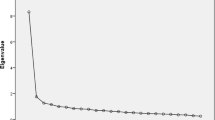Abstract
Responses to the Social Phobia and Anxiety Inventory (SPAI) were examined in 23 women with anorexia nervosa, 54 women with bulimia nervosa, 50 female college undergraduates, and 43 social phobic women. Results indicated that women with anorexia nervosa and bulimia nervosa scored comparably high to social phobic women on measures of social anxiety and that these fears were not limited to fears of eating or drinking in public. This study suggests that fears of negative evaluation in women with eating disorders may generalize beyond the fears of scrutiny of body shape and size to more traditional social situations.
Similar content being viewed by others
References
American Psychiatric Association (1987).Diagnostic and statistical manual of mental disorders, 3rd ed., rev. Washington, DC: American Psychiatric Association Press.
Beidel, D. C., Turner, S. M., Stanely, M. A., & Dancu, C. V. (1989). The Social Phobia and Anxiety Inventory: Concurrent and external validity.Behavior Therapy, 20, 417–427.
Bulik, C. M. (1987). Drug and alcohol use in bulimic women and their families.American Journal of Psychiatry, 144, 1604–1606.
Bulik, C. M., Beidel, D. C., Duchmann, E., Weltzin, T. E., & Kaye, W. H. (1991). Comparative psychopathology of women with bulimia nervosa and obsessive-compulsive disorder.Comprehensive Psychiatry.
Cooper, J. (1970). The Leyton Obsessional Inventory.Psychological Medicine, 1, 48–64.
Crisp, A. H., & Bhat, A. V. (1982). “Personality” and anorexia nervosa-the phobic avoidance stance.Psychotherapy and Psychosomatics, 38, 178–200.
Crown, S., & Crisp, A. H. (1979).Manual of the Crown-Crisp Experimental Index. London: Hodder & Stoughton.
DiNardo, P., Barlow, D., Cerny, J., Vermilyea, B., Vermilyea, J., Himaldi, W., & Waddell, M. (1986).Anxiety Disorders Interview Schedule-Revised. Albany, NY: Phobia and Anxiety Disorders Clinic.
Fleiss, J. L. (1981).Statistical Methods for Rates and Proportions. New York: John Wiley & Sons.
Hudson, J. I., Pope, H. G., Jonas, J. M., & Yurgelun-Todd, D. (1983). Phenomenological relationship of eating disorders to major affective disorder.Psychiatry Research, 9, 345–354.
Hudson, J. I., Pope, H. G., Yurgelun-Todd, D., Jonas, J. M., & Frankenburg, F. R. (1987). A controlled study of lifetime prevalence of affective and other psychiatric disorders in bulimic outpatients.American Journal of Psychiatry, 144, 1283–1287.
Johnson, C. (1985). The initial consultation for patients with bulimia and anorexia nervosa. In D. M. Garner, & P. E. Garfinkel (eds.),Handbook of psychotherapy for anorexia nervosa and bulimia (pp. 19–51). New York: Guilford Press.
Kassett, J. A., Gershon, E. S., Maxwell, M. E., Guroff, J. J., Kazuba, D. M., Smith, A. L., Brandt, H. A., & Jimerson, D. C. (1989). Psychiatric disorders in the first-degree relatives of probands with bulimia nervosa.American Journal of Psychiatry, 146, 1468–1471.
King, A. (1963). Primary and secondary anorexia nervosa syndromes.British Journal of Psychiatry, 109, 470–479.
Laessle, R. G., Kittl, S., Fichter, M. M., Wittchen, H. U., & Pirke, K. M. (1987). Major affective disorder in anorexia nervosa and bulimia.British Journal of Psychiatry, 151, 785–789.
Mezzich, J., Dow, J., Rich, C., Costello, A., & Himmelhoch, J. (1981). Developing an effective information system for a comprehensive psychiatric institute. II: Initial Evaluation Form.Behavior Research Methods and Instrumentation, 13, 464–478.
Morgan, H., & Russell, E. F. (1975). Value of family background and clinical features as predictors of long-term outcome in anorexia nervosa: Four year follow-up of 41 patients.Psychological Medicine, 5, 355–371.
Norton, G. R., Dorward, J., & Cox, B. J. (1986). Factors associated with panic attacks in non-clinical subjects.Behavior Therapy, 17, 239–252.
Rothenberg, A. (1988). Differential diagnosis of anorexia nervosa and depressive illness: A review of 11 studies.Comprehensive Psychiatry, 29, 427–432.
Rowland, C. (1970). Anorexia nervosa: A survey of the literature and review of 30 cases.International Journal of Psychiatry Clinics, 7, 37–137.
Solyom, L., Freeman, R., Thomas, C., & Miles, J. (1983). The comparative psychopathology of anorexia nervosa.International Journal of Eating Disorders, 3, 3–13.
Stern, S. L., Dixon, K. N., Nemzer, E., Lake, M. D., Sansone, R. A., Smeltzer, D. J., Lantz, S., & Schreier, S. S. (1984). Affective disorder in the families of women with normal weight bulimia.American Journal of Psychiatry, 141, 1224–1227.
Strober, M. (1980). Personality and symptomatological features in young nonchronic anorexia patients.Journal of Psychosomatic Research, 24, 353–359.
Taylor, J. A. (1953). A personality scale of manifest anxiety.Journal of Abnormal and Social Psychology, 48, 285–290.
Toner, B. B., Garfinkel, P. E., & Garner, D. M. (1986). Long term follow-up of anorexia nervosa.Psychosomatic Medicine, 48, 520–529.
Turner, S. M., & Beidel, D. C. (1988). Some further comments on the measurement of social phobia.Behaviour Research and Therapy, 26, 411–413.
Turner, S. M., Beidel, D. C., Dancu, C. V., & Stanley, A. M. (1989). An empirically derived inventory to measure social fears and anxiety: The Social Phobia and Anxiety Inventory.Psychological Assessment, 1, 35–40.
Turner, S. M., Stanley, M. A., Beidel, D. C., & Bond, L. (1989). The Social Phobia and Anxiety Inventory: Construct validity.Journal of Psychopathology and Behavioral Assessment, 11, 221–234.
Turner, S. M., Beidel, D. C., & Townsley, R. M. (1991).Social phobia: A comparison of generalized and specific subtypes and avoidant personality disorder (submitted for publication).
Warren, W. (1968). A study of anorexia nervosa in young girls.Journal of Psychology and Psychiatry, 9, 27–40.
Wolpe, J., & Lang, P. S. (1964). A fear survey schedule for use in behaviour therapy.Behaviour Research and Therapy, 2, 27–30.
Zimbardo, P. G. (1977).Shyness: What is it, what to do about it. Reading, MA: Addison Wesley.
Author information
Authors and Affiliations
Rights and permissions
About this article
Cite this article
Bulik, C.M., Beidel, D.C., Duchmann, E. et al. An analysis of social anxiety in anorexic, bulimic, social phobic, and control women. J Psychopathol Behav Assess 13, 199–211 (1991). https://doi.org/10.1007/BF00960784
Accepted:
Issue Date:
DOI: https://doi.org/10.1007/BF00960784




